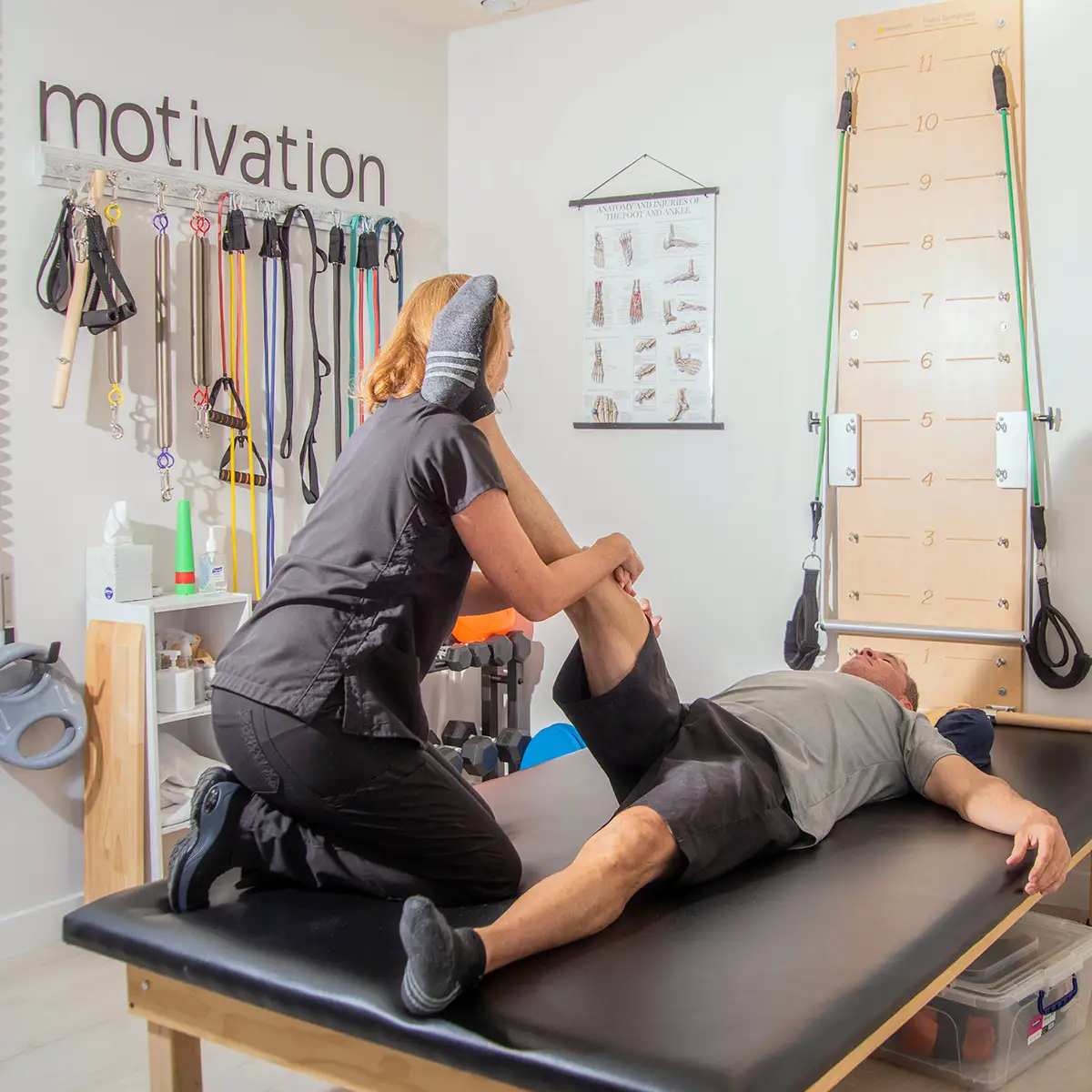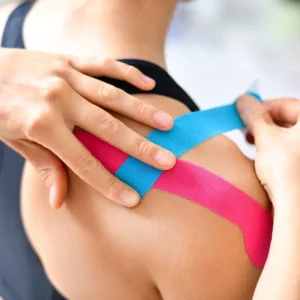Physical Therapy
Achieve Faster Recovery and Lasting Results
Physical therapy (PT), particularly when combined with chiropractic care, is extremely useful in helping you heal, reduce your pain, regain mobility, and generally feel better. We feature both a hands-on approach as well as the use of targeted equipment to help you feel your best.
Our patients generally come to see us for physical therapy after a doctor or nurse practitioner has prescribed it. However, if you’re seeing one of our other providers here at Cima Health and they think PT can help you achieve overall wellness, we may see you on an internal referral. And if your physical therapist thinks you could benefit from a chiropractic adjustment, we’ll refer you to one of our chiropractic care providers. We all work together at our Palm Beach Gardens health center to help you achieve whole-body well-being.

Who Physical Therapy Helps
At Cima Health, we treat you, not your condition. You deserve health care providers who listen to you and develop an integrative plan of care to address your concerns and goals. You may benefit from physical therapy if:
If You’re Recovering from Surgery
If you’ve had knee replacement surgery, hip replacement surgery, rotator cuff surgery, ACL reconstruction, or other surgery, it takes time to get full mobility back. You need to first get used to using that body part again, and get your strength back. PT can help you do that.
If You’re Recovering from a Sports Injury
We help pro athletes, amateur athletes, and weekend warriors recover from sports injuries. PT combined with massage therapy can work wonders. Our physical therapists can also help you improve your form to help prevent future injuries.
If You Were Injured in a Car Accident
If you’ve been injured in a car accident, physical therapy along with chiropractic care can help you get back to your life. We can work with your insurance company as well as your lawyer to ensure you get the care you need, and everything is well-documented.
If You Suffered a Stroke
Physical therapy and physical rehabilitation are critical components in helping you recover from a stroke. A physical therapist will help you regain mobility, learn to move safely, improve your balance, and help you learn to live with what may be a lifelong disability.
If You Have a Chronic Illness
PT can be a very useful tool in treatment of a chronic illness, as well. Examples include: multiple sclerosis, Parkinson’s disease, and osteoarthritis, to name a few.

Benefits of Physical Therapy
Physical therapy has a range of benefits, including, but not limited to:
- Speeds up healing.
- Provides pain relief for acute or chronic pain.
- Improves mobility recovery.
- Can help you avoid surgery.
- Helps you recover after surgery.
- Helps you with injury recovery.
- Improves balance and helps prevent falls.
When you have a physical therapy program as part of an integrative care plan at Cima Health, you may also see a chiropractor, massage therapist, or receive joint injections. You’ll have a plan tailored to your unique situation, with a goal of providing you restorative, lifelong solutions.
Types of Physical Therapy
We employ multiple types of physical therapy techniques to help you heal. Some of these therapies are hands-on, while others involve the use of equipment, and still others involve programs you can continue at home. Which types we use in your care will depend on the specifics of your situation.
Physical Rehabilitation vs Physical Therapy
Contrary to what you might think, physical therapy and physical rehabilitation are not the exact same thing. Physical rehabilitation is the umbrella term, and physical therapy is a component of that. Physical rehabilitation can start in the hospital after you have had surgery, or received treatment after a heart attack or stroke.
Our team works with you after you have been discharged to help you restore your health to the fullest extent.
Orthopedic & Neurological Physical Therapy
Orthopedic PT specializes in diagnosing and treating conditions that affect any part of your musculoskeletal system, including your bones, joints, muscles, tendons, and ligaments. Neurological physical therapy focuses on treating patients with movement and mobility issues due to disease or injury to the central nervous system. At Cima Health, we practice both, to help your whole body.
Manual Therapy
Manual therapy is one of the most common types of physical therapy, and uses specialized hands-on techniques. There are two main kinds of manual therapy: soft tissues manipulation and joint mobilization.
Soft Tissue Manipulation
Soft tissue work involves using skilled hand movements to apply pressure to soft tissues (muscles, tendons, ligaments) in order to offer pain relief, reduce inflammation, break scar tissue, relax muscles, promote blood circulation.
Joint Mobilization
Joint mobilization or manipulation involves a trained physical therapist pulling, pushing, twisting, or otherwise manipulating your joint(s) to get them into the correct position. This can help loosen tissues around the joint, improve mobility, and reduce pain.
Myofascial Release
Myofascial release focuses on relieving the chronic pain from myofascial pain syndrome by easing the tension and tightness of the “trigger points” in your myofascial tissues. Myofascial release can also help people who suffer from chronic headaches or venal insufficiency.
Class 4 K-Laser Therapy
The Class IV K-laser is an FDA-approved therapy deemed safe, effective and painless for a variety of painful conditions. The laser accelerates and stimulates cell reproduction and growth, which leads to faster repair of damaged tissue, moderates the inflammatory response, and provides pain relief. The benefits of K-Laser therapy are enhanced when combined with manual therapy to improve mobility and decrease soft tissue restrictions.
Shock Wave Therapy
Shock wave therapy is nearly as high-tech as it sounds. The full name is extracorporeal shock wave therapy (ESWT). It’s a non-invasive technique where we use a tool to apply high-energy acoustic waves to break down tissue to promote healing. It shows potential for use to help tendinopathy, knee osteoarthritis, plantar fasciitis, and more.
Dry Needling
Dry needling is a PT technique that uses a thin monofilament needle to target trigger points to help manage neuromusculoskeletal pain and movement impairments. Dr. Drake is certified in dry needing for Craniofacial, Cervicothoracic, UE conditions, Lumbopelvic, and LE conditions.
Cupping Therapy
Orthopedic cupping therapy is an ancient form of alternative medicine updated for today. By placing cups on parts of your body to create suction, cupping therapy can help reduce pain and inflammation. It is a complementary treatment to other physical therapy modalities.
Kinesio Taping
You may have seen Kinesio Taping on a pro athlete or Olympic athlete. It’s a special type of tape that we apply to help reduce pain and facilitate lymphatic drainage. The tape does this by microscopically lifting the skin, which allows for decreased inflammation in affected areas. It can help optimize sports performance, but can also prevent injury, and help with post-surgical healing.
Stretching Programs
Daily stretching is part of any physical therapy routine. We also offer gentle stretching programs for clients who want to maintain mobility. We tailor programs to your individual needs.
Pilates
Pilates exercises focus on strengthening your core and muscle tone to help you recover. Pilates can also help increase your body awareness, or proprioception. We use a Rehab V2Max reformer, springboard, and spine corrector, in addition to specific props, to ensure we can work with any level of patient to enhance your well-being and maximize your potential for recovery.
Fall Prevention Program
We use evidence-based fall prevention programs to help older adults and other patients with mobility issues learn how to prevent falls. This can involve educating you about changes to your environment, as well as helping you safely exercise more, gain strength, and improve your balance.
Auto Accident Cases
We see a lot of patients with auto accident injuries. From helping you recover from whiplash to helping you recover from more extensive injuries, our team works together to include physical therapy, chiropractic care, and other modalities to restore your health.
Physical Therapy FAQs
If you’ve been prescribed physical therapy and you’ve never visited a physical therapist before, you probably have questions. Here we’ve attempted to answer the most frequently asked questions we get from clients. If you have a question you don’t see here, please feel free to call and ask, or ask us at your initial assessment.
1. I’m in a lot of pain. Can I still get physical therapy?
Yes! We understand that you may feel unable to perform specific movements. We’ll work with your comfort level and what is appropriate for you, no matter what your limitations may be. With stretching and other PT treatments, you may have reduced pain by the time you leave your session.
2. What types of physical therapy might I do at my appointment?
Most often, we utilize manual therapy and stretching to lengthen adaptively shortened muscles. Then we work with you on strengthening to maintain the newly acquired movement to ensure long-lasting improvements and prevention of re-injury. We can then progress to making larger movements and rehabilitative exercises.
3. How often will I need to see a physical therapist?
The frequency of your visits is tailored to you. Our care is not one-size-fits-all. If you come in with a minor issue, you won’t need to see us as much. If you can’t walk, for example, you may require more frequent visits.
4. How long are physical therapy sessions?
There isn’t a specific time limit for your physical therapy sessions. Your initial visit will include an assessment and a first treatment, so may be slightly longer than follow-up visits. In general, you can expect a session to last between 45 minutes and 75 minutes. It will depend on your level of recovery and what treatments we utilize.
5. How do you measure my progress?
At your first visit, the physical therapist will take measurements of your range of movement, level of pain, and more. During follow-up sessions, your therapist will talk with you about progress you are making – it may be incremental at first. You may notice yourself that you have increased mobility and less pain. We will do a full reassessment every 30 days, or before your follow-up appointment with your doctor. We will then compare the new measurements and results both subjectively and objectively to your original assessment to document your progress.
6. How much does physical therapy cost?
This will depend on the severity of your case, and what your insurance coverage is. But we can assure you, a physical therapy session is not expensive, and the reduction in pain and increased mobility makes it worth every penny.
7. Does Medicare cover physical therapy?
Yes, as long as a health care provider, including your doctor or nurse practitioner certifies it is medically necessary to improve your health. Learn more about your coverage at Medicare.gov.
8. Can I see the same physical therapist each time?
Yes! We can schedule each of your visits with the same provider, as long as that works with your schedule.
What Our Patients Are Saying
Increase Mobility and Have Better Health
In CTA, discuss that Cima is more than a physical therapy clinic – multiple providers for comprehensive care, integrative care for lifelong, restorative solutions.
Book your physical therapy assessment today, and get started on the path to increased mobility and better health.

